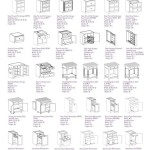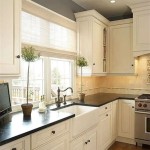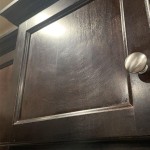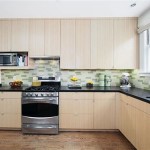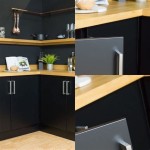Elevating Kitchen Aesthetics: Innovative Kitchen Island Display Ideas
The kitchen island has evolved from a mere workspace to a central focal point within the modern home. Its versatility allows it to function as a preparation area, dining surface, and social gathering spot. Beyond these functional roles, the kitchen island presents a prime opportunity for showcasing personal style and enhancing the overall aesthetic of the kitchen through carefully curated displays. Thoughtful display choices can transform an ordinary island into a captivating feature that reflects the homeowner's personality and complements the kitchen's design.
Effective island displays are not simply about filling space; they involve considering the kitchen's overall design scheme, the available space on the island, and the desired impact. The choice of items, their arrangement, and the materials used all contribute to the final effect. A well-executed display can add warmth, color, texture, and visual interest to the kitchen, making it a more inviting and aesthetically pleasing space.
This article explores various kitchen island display ideas, providing guidance on how to select and arrange items to create visually appealing and functional displays. It will delve into considerations for different kitchen styles, from modern and minimalist to farmhouse and traditional, offering practical tips and inspiration for transforming a kitchen island into a stunning centerpiece.
Integrating Functional and Decorative Elements
One of the most effective approaches to kitchen island displays is to blend functional items with decorative elements. This approach ensures that the display is not only visually appealing but also serves a practical purpose. Items that are frequently used in the kitchen, such as cookbooks, cutting boards, and utensil holders, can be incorporated into the display alongside decorative items like vases, plants, and sculptures.
When integrating functional items, it is important to choose pieces that complement the kitchen's style and color scheme. For example, wooden cutting boards and ceramic utensil holders can add a rustic touch to a farmhouse-style kitchen, while sleek metal utensils and minimalist serving dishes can enhance the clean lines of a modern kitchen. Consider the materials and textures of the items, ensuring they harmonize with each other and with the overall design of the kitchen.
Arranging functional items artfully is key to creating a visually appealing display. Instead of simply placing them on the island, consider grouping them together to create a sense of cohesion. For example, a stack of cookbooks can be placed next to a decorative vase, with a small cutting board propped up against the vase to add visual interest. Utensil holders can be arranged on a tray or platter, alongside a small plant or a decorative bowl of fruit. The goal is to create a balanced and visually engaging display that seamlessly blends functionality with aesthetics.
Another important consideration is accessibility. While the display should be visually appealing, it should also be practical and easy to use. Ensure that frequently used items are readily accessible and that the display does not obstruct the work area on the island. This can be achieved by keeping the display relatively compact and organized, and by choosing items that are easy to move or rearrange as needed.
For example, a small herb garden can be both functional and decorative. Growing herbs on the kitchen island adds a touch of freshness and greenery to the space, while also providing a convenient source of fresh herbs for cooking. The herbs can be planted in attractive pots or containers that complement the kitchen's style, and arranged in a visually appealing manner. Similarly, a collection of decorative salt and pepper shakers can be both functional and visually interesting, adding a touch of personality to the island display.
The Power of Strategic Styling
Strategic styling involves carefully considering the composition, color palette, and textures of the display to create a cohesive and visually appealing arrangement. This approach requires a keen eye for detail and an understanding of basic design principles, such as balance, symmetry, and contrast.
Composition is a key element of strategic styling. The items in the display should be arranged in a way that is visually balanced and pleasing to the eye. This can be achieved by varying the height, size, and shape of the items, and by creating a focal point within the display. A focal point can be a larger item, a brightly colored object, or a particularly interesting texture. Arrange smaller items around the focal point to create a sense of depth and dimension.
Color palette is another important consideration. The colors in the display should complement the kitchen's overall color scheme and create a sense of harmony. This can be achieved by choosing items in similar colors or by using complementary colors to create contrast. Neutral colors, such as white, gray, and beige, can provide a calming and sophisticated backdrop, while pops of color, such as blue, green, or yellow, can add visual interest and energy to the display.
The application of textures is vital for adding depth and interest to the display. Incorporating a variety of textures, such as smooth glass, rough wood, and soft fabric, can create a more engaging and tactile experience. For example, a glass vase can be placed next to a wooden cutting board, with a linen napkin draped over the board to add a soft touch. The contrast between the different textures will make the display more visually appealing and inviting.
Consider the use of layering when styling the kitchen island. Layering involves arranging items in front of each other to create a sense of depth and dimension. This can be achieved by placing a larger item in the back of the display, with smaller items arranged in front of it. Layering can also be used to create a sense of visual interest by overlapping different textures and colors.
For example, a large wooden tray can be placed on the island, with a stack of cookbooks arranged on the tray. A smaller vase of flowers can be placed in front of the cookbooks, with a decorative bowl of fruit arranged in front of the vase. The layering of these items will create a visually appealing and dynamic display that adds depth and interest to the kitchen.
Illumination and Materials
The selection of materials and the integration of lighting play a crucial role in enhancing the visual impact of a kitchen island display. The materials used in the display should complement the kitchen's overall design and create a sense of harmony. Incorporating lighting into the display can highlight specific items and add warmth and ambiance to the space.
When choosing materials for the display, consider the kitchen's style and color scheme. Natural materials, such as wood, stone, and ceramic, can add warmth and texture to the space, while sleek materials, such as metal and glass, can create a more modern and minimalist look. The materials should also be durable and easy to clean, as they will be exposed to spills and splashes in the kitchen.
Different types of wood can be used to add visual interest to the display. For example, a reclaimed wood cutting board can add a rustic touch to a farmhouse-style kitchen, while a sleek walnut serving platter can enhance the elegance of a modern kitchen. Stone materials, such as marble and granite, can also be used to add a touch of luxury to the display. Ceramic items, such as vases and bowls, can be used to add color and texture to the space.
Lighting is a powerful tool for enhancing the visual impact of a kitchen island display. Consider adding recessed lighting above the island to highlight the display from above. This will draw attention to the display and create a sense of drama. Alternatively, pendant lights can be hung above the island to provide both task lighting and ambient lighting. The pendant lights can be chosen to complement the kitchen's style and add a decorative touch to the space.
Another option is to incorporate lighting directly into the display. This can be achieved by using battery-operated fairy lights or LED strips to illuminate specific items. For example, a string of fairy lights can be draped around a vase of flowers, or an LED strip can be placed under a shelf to highlight a collection of cookbooks. The lighting will add a warm and inviting glow to the display and create a more intimate atmosphere in the kitchen.
Candles are another effective way to add ambiance to the kitchen island display. Candles can be placed in decorative holders and arranged on the island to create a warm and inviting glow. Scented candles can also be used to add a pleasant aroma to the kitchen. However, it is important to exercise caution when using candles and to ensure that they are placed away from flammable materials.
The interplay between materials and illumination can significantly elevate the overall aesthetic of the kitchen island display. By carefully considering the textures, colors, and lighting, it is possible to create a captivating and functional centerpiece that transforms the kitchen into a more inviting and stylish space. The integration of these elements requires a thoughtful approach, ensuring that the display seamlessly blends with the existing design and reflects the homeowner's personal taste.

18 Easy And Stylish Kitchen Island Decor Ideas

18 Easy And Stylish Kitchen Island Decor Ideas

Island Paradise Four Ways To Style Your Kitchen Nell Hill S

47 Best Kitchen Island Ideas Stylish Unique Design Tips

Kitchen Island Display Cabinet A Storied Style

47 Best Kitchen Island Ideas Stylish Unique Design Tips

Ideas For Kitchen Counter Styling Decor Gold Designs

Inspiring Kitchen Island Ideas The Home Depot

40 Kitchen Island Ideas To Upgrade Your Space Cabinet Kings

11 Cool Kitchen Island Ideas Kettle Co
Related Posts

